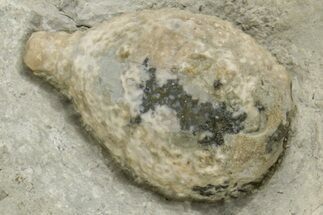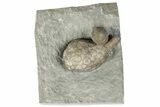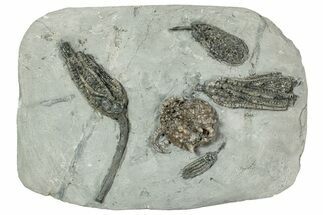This Specimen has been sold.
Fossil Cystoid (Holocystites) and Brachiopod Association - Indiana
This is an association of a fossil cystoid (Holocystites scutellatus) and a brachiopod (Atrypa sp.) from the Silurian period Osgood Shale of Napolean, Indiana. They have been exposed from the rock using air abrasives. The cystoid measures 1.6" long and the brachiopod is .5" long. It comes with an acrylic display stand.
Cystoids are extinct echinoderms similar to crinoids. They consist of a stalk, theca (body), and brachials (feeding arms). Most lived fixed to the seafloor, but some were more mobile. Like modern echinoderms, cystoids were arranged in a fivefold symmetric pattern and had a water vascular system. However, unlike most echinoderms, cystoids had triangular calcite plates at their body openings containing pores that are thought to have been for breathing.
Cystoids first appear in the Cambrian Period and reached peak diversity during the Ordivician and Silurian Periods. Cystoids died out at the end of the Devonian or early in the Carboniferous Period.
Cystoids resembled flowers, but were in fact animals. They had a stem that attached them to the seafloor, a theca, and brachials. The theca contained the cystoid's vital organs and was made up of calcite plates that formed a spherical or ovate body. The brachials were the feeding arms that extended from the top of the theca, arranged in three- or five-fold symmetry, and funneled food to the mouth at their center. Cystoids and crinoids look similar but have some distinct differences. The main difference is in the shape of the main body of the organisms: cystoids had a spherical or ovate theca, while crinoids had a cup shaped calyx. Cystoids also had triangular plates at body openings while crinoids had variably shaped plates.
Cystoids first appear in the Cambrian Period and reached peak diversity during the Ordivician and Silurian Periods. Cystoids died out at the end of the Devonian or early in the Carboniferous Period.
Cystoids resembled flowers, but were in fact animals. They had a stem that attached them to the seafloor, a theca, and brachials. The theca contained the cystoid's vital organs and was made up of calcite plates that formed a spherical or ovate body. The brachials were the feeding arms that extended from the top of the theca, arranged in three- or five-fold symmetry, and funneled food to the mouth at their center. Cystoids and crinoids look similar but have some distinct differences. The main difference is in the shape of the main body of the organisms: cystoids had a spherical or ovate theca, while crinoids had a cup shaped calyx. Cystoids also had triangular plates at body openings while crinoids had variably shaped plates.
Brachiopods are members of the phylum Brachiopoda. They are clam-like with wide shells composed of two halves called valves. They are filter feeders that live fixed to rocks or on the seafloor. Brachiopods first appeared in the early Cambrian as simple forms with non-articulating shells. Their diversity peaked during the Devonian, and there are currently 12,000 described fossil species of Brachiopoda from 5,000 genera. Most species of brachiopod died out during the Permian-Triassic Extinction but about 450 species still live today. They live in cold marine environments like polar seas or continental shelves and slopes. The largest fossil Brachiopod found is 7.9 inches (200 mm), but most are 2-4 inches (3-8 cm). Living Brachiopods also fall into this range.
Brachiopods are more closely related to Bryozoans than Mollusks. The easiest differences to identify are in the shells of clams, part of the mollusk family, and Brachiopods. Mollusk shells are divided into left and right while brachiopod shells are divided top (dorsal) and bottom (ventral). Mollusk shells are usually equal on the right and left. In brachiopods, the bottom shell is larger than the top. The other big difference is in how they feed: both are filter feeders, but mollusks extend their filter into the water and pull food into their shells. Brachiopods have internal feeding structures: water is drawn into the shell where the food is filtered out before expelling it out.
Brachiopods are more closely related to Bryozoans than Mollusks. The easiest differences to identify are in the shells of clams, part of the mollusk family, and Brachiopods. Mollusk shells are divided into left and right while brachiopod shells are divided top (dorsal) and bottom (ventral). Mollusk shells are usually equal on the right and left. In brachiopods, the bottom shell is larger than the top. The other big difference is in how they feed: both are filter feeders, but mollusks extend their filter into the water and pull food into their shells. Brachiopods have internal feeding structures: water is drawn into the shell where the food is filtered out before expelling it out.
SPECIES
Holocystites scutellatus & Atrypa sp.
AGE
LOCATION
Napolean, Indiana
FORMATION
Osgood Shale
SIZE
Cystoid: 1.6", Brachiopod: .5", Rock: 2.8 x 2.4"
CATEGORY
SUB CATEGORY
ITEM
#191008
We guarantee the authenticity of all of our specimens.
 Reviews
Reviews












